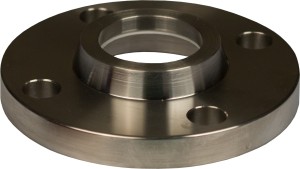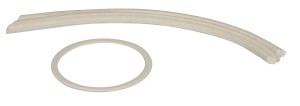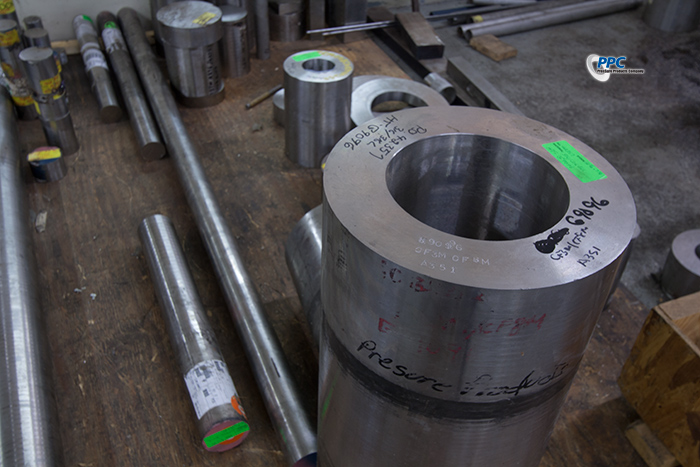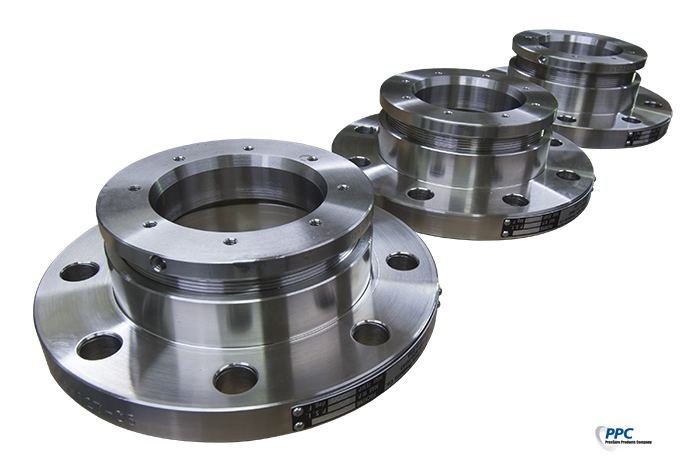 |
FAQ: All About Sight Glasses
What is a sight glass?
Also called sight window or sight port, a sight glass unit is a suitably robust window that allows convenient and/or safe visual observation of the interior of an enclosed volume.
The distinction from a general window arises from the required role. Whereas general windows are not intended to observe anything in particular, a window is referred to as a sight glass if it is intended to observe a specific and important feature within the enclosed volume. This observation target could be the fluid itself, a flow indicating device, or some phenomenon taking place within the enclosed volume.
These units are required to maintain an essentially hermetic separation between the observer and the observation target, although exceptions exist.
Read more about the different types of sight glasses. What are the components of a sight glass, and what are their roles?
Glass, or the medium that is transparent (or at least translucent) in the desired electromagnetic wavelength, is obviously the operational component in every sight glass unit.

Unit Body
Unit body that holds the transparent glass medium in place must also be present in all sight glasses, obviously. Most commercially available sight windows are distinct from one another in the way the unit body holds the transparent glass. Aside from simply holding the glass in place (like in any other window), the unit body is often designed to manage stresses transmitted to the glass. For pressure bearing units in particular, the unit body must distribute the sealing stresses on glass surfaces properly, while isolating the glass from the minute but still significant flexing of the pressure vessel to which the unit is mounted. In general, different pressure ratings of sight glasses arise from different unit body designs, rather than different glass materials or even thicknesses. Finally, unit body design can be an integral part of how a given unit manages corrosion protection. Unit body is not necessarily single piece.

Gaskets and Packing Material
Gaskets or packing material are always present because of the sealing requirement.
Extra features can be present as needed. For example, a sight glass used to observe a condensing process will become covered with liquid droplets, which makes observation difficult. Liquid spray ring or a window wiper is often integrated into the sight glass design in such cases. Other common inclusions are integrated fittings for specialized instrumentation, as well as lighting fixtures.
What materials are used in a sight glass, and how are they chosen?
The types of metal, glass and seal material used in a sight glass are entirely dependent on the required observation mechanism, process fluid, process temperature and process pressure.
Transparent medium, or the "glass," has been made from a number of transparent solids. The point of any window is to allow "sight" though it, so its first characteristic must be reasonably high transmission within the desired electromagnetic spectrum. The vast majority of applications require transmission within the visual spectrum, which allows for the use of common window materials such as silicate glasses and transparent plastics. But other materials are used as appropriate. If transmission in long infrared range is needed for either thermal imaging or carbon dioxide laser illumination, zinc selenide is a common choice for a window material. If someone needed a "sight glass" for neutron scans, the window would most likely be beryllium. (By the way, such have been made; they look like any other industrial sight glass, except that there is a metallic plate where glass should be.)
Assuming that the optical requirements allow a range of materials, chemical compatibility and temperature requirements, and sometimes required pressures, will determine the choice of materials. Learn more about these topics at our Tech Talks. Cost is almost always an unstated specification; sapphire windows can serve in most sight glass applications, but its prohibitive cost makes it very rare. Most commonly used window media are soda lime and borosilicate glass, and fused quartz (vitrified or glassy silica, not to be confused with crystalline quartz). If required, coatings are applied to impart the requisite corrosion protection to the window material.
Unit body can also be made from any number of materials. For consumer applications, such as sight glasses on coffee makers or motorcycle engines, the body is simple whatever the coffee makers or engine casing is made of. For industrial sight glasses, corrosion requirements, cost, and machinability usually drive material requirements. Chemically appropriate plastics can be used in applications without any pressure requirements (like coffee makers), but their flexibility rules out their use in pressure bearing applications.
Most common materials for pressure bearing industrial sight glass bodies are various carbon steels and 300 series stainless steels, and their casting equivalents. Carbon steel units are commonly painted to prevent rusting. In general, metals are required to match whatever unit or device the sight glass is attached to, in order to eliminate galvanic corrosion potential.
For corrosive applications, very corrosion resistant super alloys are specified. These alloys, such as various grades of Hastelloys or Inconels, are both very expensive and difficult to machine. In order to reduce cost, some unit bodies are of heterogeneous construction, consisting of a cheaper stress bearing material and the more expensive wetted insert that keeps the corrosive process fluid away from the main body.
Sealing materials such as gaskets and packings can be of plastics, other soft carbonaceous materials, or even metals. Chemical compatibility, maximum service temperature, and softness are primary selection criteria. The most stressed location on window material' s surface is the seat of the sealing gasket or packing. Therefore, it is advantageous to use as soft a sealing material as possible so as to minimize the gasket seating stress. That being said, the gaskets must be chemically compatible with the process fluids, and be able to tolerate the required temperatures. For example, PTFE is a very chemically resistant polymer, but it is notorious for its creep behavior, and developing leaks. Metal based gaskets and graphite based materials offer high service temperatures, but they require much more seating stress than softer polymers to seal effectively. Therefore, over-specifying required pressure or temperature values is often counter-productive. Since re-sealing of slow leaks is the most likely maintenance task for sight glass units, overall cost of ownership is minimized by not exceeding actual operating conditions so that optimal sealing material could be used.
How are industrial sight glasses made?
The highest cost item in an industrial unit is usually the unit body. Casting techniques are very commonly used to make the lower cost bodies. There is no real restriction on the kinds of casting methods, but investment casting methods are popular because of their relatively precise geometry control. Since the unit bodies are required to have a sealing surface present, some machining is required, as casting methods are usually not able to produce the required level of precision. Castings are particularly cost effective for very tough super alloys, as it requires the least amount of machining to finish a product while minimizing material waste.

Metal materials (round bar and spin-casted tubing or 'blanks') used to make sight glass units
There are several cases when unit bodies cannot be cast. The required metal might be too electropositive for casting without atmosphere control (titanium, zirconium, etc.). While such metals can certainly be cast, the required production environment for preventing oxidation during casting process, combined with the relatively rarity of such applications, makes them uneconomical to cast. Some plants also have an overall policy for only allowing forging grade structural metals in their locations. These policies are irrelevant for sight glass applications, as the weak member is the transparent window material rather than the heavy metal body, but it is easier to make the unit body out of policy compliant metals than to try to obtain exceptions to the policy. There are also non-standard sizes/designs that are not worth the investment involved in producing molds for castings. And there are sometimes delivery lead time considerations where a casting cannot be obtained quickly enough, and more expensive fabrication methods are used in order to accelerate delivery times.
When castings are not used, any subtractive machining technique can be used with virtually any metal stock. Typically, the machining starts with tube, bar or plate stock, and the stock is subjected to appropriate machining operations. For circular unit bodies, standard pipe flanges can sometimes be used as starting stock for bodies.

New sight glass unit bodies ready for shipment
For the window material, commercially available float glass is used whenever possible. Float glass is cut and ground to desired shapes. If desired, they can be tempered through standard tempering processes. If very thick glass is required, rolled glass stocks can be used, as they are (or can be) available in greater thicknesses. These require not only cutting and grinding, but also lapping and polishing, adding to cost. If even greater thicknesses are required, glass sheets can be stacked and fused in order to create virtually any thickness. Virtually all glass used are of silicate composition - soda lime silicate, borosilicate, or fused quartz. Crystalline materials, like sapphire or zinc selenide, are used only for very specific needs that cannot be met by cheaper materials.
Plastic window materials are similar, except that there is usually no reason to make them thicker (nor is it easy to do so); if greater rigidity is required, silicate glass should be used instead.
Glass can be sandwiched together for greater impact resistance, at the expense of peak pressure rating for a given resulting thickness. In such arrangements, each sheet of glass layer needs to be able to hold the required pressure with requisite safety factors. The layers are bonded with a relatively soft adhesive that will shear rather than transmit the fracturing stress onto the attached layer. The trade-off for this fracture resistance is that they can only a quarter of a the pressure that can be tolerated by a single piece lens of the same total thickness.
For service in hydroxyl attack environments, glass can be coated with polymeric barriers. PTFE (Teflon) is the most popular. These coatings are not quite clear when dry, but wetting it with the process liquid makes the coating completely transparent.
Fused sight glasses are made very differently. The metal ring and glass core are placed in an atmospherically controlled furnace, and heated until the glass melts and fills out the metal ring. If the furnace cycle temperature is high enough, any form of glass can be used. After the melting out, the furnace is cooled through a controlled annealing schedule to control the stresses imposed in the glass. The pieces are finished by grinding and polishing techniques that are similar to glass polishing practices.
Where are sight glasses commonly used?
They are common (whether or not you referred to them as such) in everyday life. Most coffee makers or espresso machines have a type of liquid level gauge to let you see how much water you've added. Motorcycle engines have sight glasses to allow visual inspection of oil levels.
Industrial sight glasses are found in processes or plants where liquid flow inspection and control is critical. They were universal early in the industrial age where steam engines were the only mechanical motive power source and visual inspection was the only possible feedback mechanism. Industrial boiler water level inspection is still a very common application for sight glasses. There are now additional variations on that application; the sight glass units in nuclear reactor service have unit bodies made of zirconium, and those are almost certainly the most expensive sight glass bodies ever made!
Of course, there are many more applications now, reflecting the many more industries that deal with critical fluid control processes. They are used to inspect the fluid itself, as in boiler applications or petrochemical applications. Chemical and biological reactor plants often have some at critical places in order to serve as an old fashioned backup for automated instrumentation. Also, they are used with digital cameras for continuous manned monitoring of a number of critical points in a given plant.
The advent of low cost, high speed digital photography and more advanced optical measurement techniques have created new applications for specialty sight glasses. With such new tools, it became possible to literally see rapid fluid mechanical or chemical phenomena in slow motion. For such applications, researchers specify sight glass units that could operate in the pressure and temperature regimes that would make such experiments meaningful.
Laser measurements of chemical reactions are routinely performed, with the laser being separated from the chemical reaction chamber by a zinc selenide window. High pressure combustion research, fuel atomization characterization, and such, lead to challenging design requirements for sight glasses, and the limit of the conditions at which such experiments can be performed is set by sight glasses on the research reactors. There had even been interest from a major jet engine manufacturer for a sight glass unit that would permit observation into a jet engine combustion chamber! (That was a bad idea; whatever knowledge might have been gained by staring into a jet engine combustion chamber -through a digital camera, one can only hope -could not possibility be worth the cost of designing and building a unit to withstand such conditions. Did they expect to see something besides fire?)
What information do I need in order to generate a specification for an industrial or specialty sight glass?
Generating a sight glass specification is like generating any other structural engineering component specification, with one major exception. In structural engineering, it is common practice to "overengineer" an article in order to create a margin of safety. Such cases presuppose that the only risk factor is excessive mechanical load. Since sight glasses are actually interfaces into a different chemical environment, and since silicate glass strengthening often results in making them more prone to corrosion, there are other factors to consider.
In general, the first thing to do is to figure out the process upset scenarios that the sight glass will need to tolerate. Since there are multiple and often conflicting safety parameters to consider, minimizing the overall risk involves understanding the actual upset scenarios. Once that upset scenario has been specified, the following factors should be considered.
Pressure. Both normal operating pressure and peak upset pressure. Preventing burst failure at high pressures is trivially easy; one can just specify thicker glass. However, this does not mean that the sight glass is actually safer.
Impact damage risk. Glass members are usually pretty thick, and are quite able to absorb hits from projectiles that can be picked up by strong winds. Is more impact resistance REALLY required? Laminated lenses can be used, but other strengthening techniques that involve pre-stressing glass can make it more vulnerable to corrosion damage.
Process fluid. What kind of glass materials and what kind of metals will this fluid corrode? Even if the fluid does not corrode the wetted materials directly, it can still serve as the electrolyte for galvanic corrosion of mismatched metals. If the maximum process upset temperature has to be tolerated for any length of time, the chemical activity of the fluid needs to be considered at this temperature. Chemical activity increases exponentially with temperature.
Temperature at normal service. If maximum upset temperature is expected to last for more than a few seconds, then temperature at maximum upset condition should be used for specification. Glass materials lose strength very quickly above their maximum rated service temperature. This is particularly important for high pressure gas processes. In many gas pressure raising processes, pressure spikes can only happen with accompanying temperature spikes.
Leak tolerance. Some applications can allow a small leak. Compressed air is an obvious example. For applications that require both high temperature and high pressure, this is an important parameter. If minor leakage during normal operation is permitted, lower sealing stresses may be possible, which will leave allowance for thermal expansion mismatch between the metal and glass members.
Normal maintenance and handling. Certain types of sight glasses are easier to handle and maintain. If diligent, "by the book," maintenance discipline is difficult to achieve for whatever reason, it is possible to specify a design that will tolerate less precise practices. Fused glass is probably the most tolerant of handling abuse, and sidewall sealed designs tolerate excessive sealing stresses well.
Where can I buy a sight glass?
Sight glasses can be ordered online or by phone. See the buying a sight glass page for more information.
| This web site is provided by: |  | Copyright 2015, All Rights Reserved. |
|
 |
|
|



